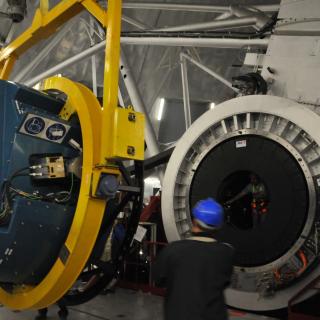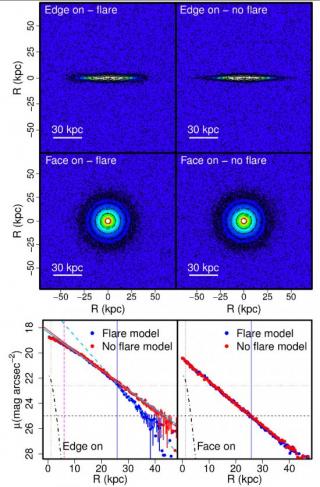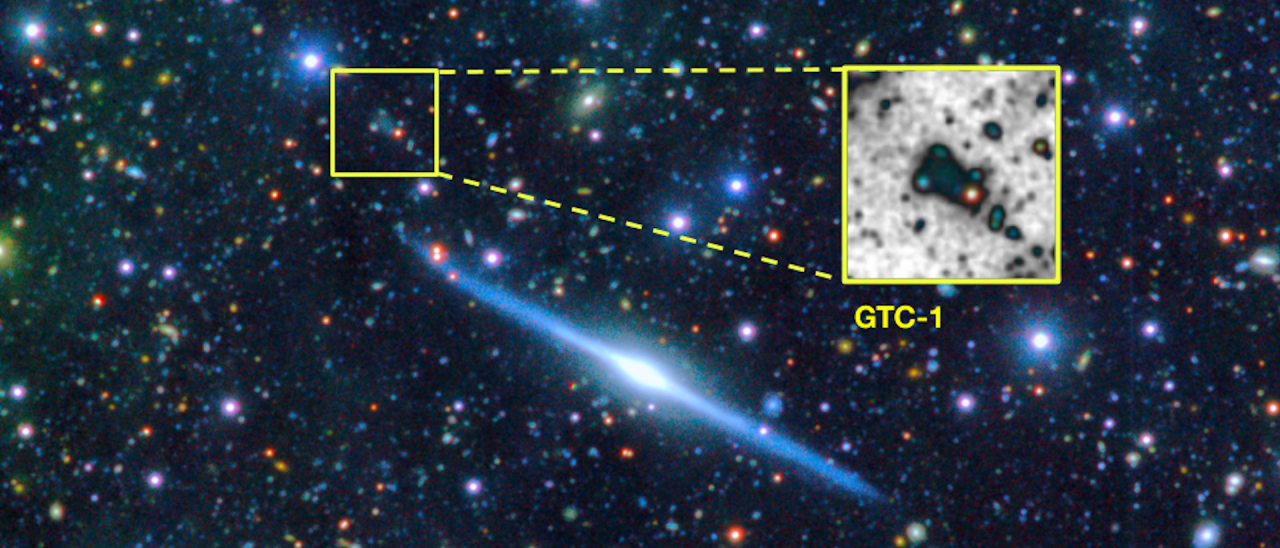Colour image of the edge-on galaxy UGC11859 (centre) obtained with the OSIRIS camera on the Grantecan. In the yellow square, the low surface brightness galaxy GTC-1, highlighting the low surface brightness emission in shades of grey on a white background. The deformations observed in the disc of the galaxy UGC11859 suggest that GTC-1 is a satellite galaxy. Credit: Ossa-Fuentes (University of Valparaiso) / IAC / GTC / NASA Ames.
An international scientific team, including the Instituto de Astrofísica de Canarias (IAC), has detected distortions in the brightness of a galaxy's disc that could be explained by the gravitational effect of an unknown neighbouring galaxy. Named GTC-1, the satellite galaxy was discovered using ultra-deep images obtained with the OSIRIS camera of the Gran Telescopio Canarias, located at the Roque de los Muchachos Observatory in La Palma. The finding provides a possible explanation for a puzzle about way the light fades out at the edges of galaxy disks, a mystery that has bothered the scientific community for decades. The result is published in the prestigious Astrophysical Journal.
In 1980 astronomers found that when they studied images of galaxies which are edge-on to us, their brightness drops off very sharply at the edges. This truncation of the light was an important clue to the way galaxies were formed. However, it took several decades, and the use of CCD detectors in astronomical observations, to begin to understand this phenomenon.
In the first decade of the new millennium, research groups found that the gas in some galaxy discs, in particular the gas at the edge of the Milky Way, showed a flared structure in which the gas near the disk edge feels less gravity towards the plane of the galaxy, and spreads upwards. Some astronomers proposed that if the stars in the disks also had a flared structure, the brightness of a disk when observed edge-on could show a truncation, unlike the same galaxy observed face-on, although they failed to find flared discs as they expected.
Now, international research, led by the University of Valparaíso (Chile), has found the first evidence of an edge-on galaxy whose disc is sharply truncated, and also shows a flare. The galaxy, named UGC 11859, was observed with the OSIRIS camera of the Gran Telescopio Canarias (GTC or Grantecan), currently the largest optical-infrared telescope in the world, located at the Roque de los Muchachos Observatory in La Palma.
"The first reason for this discovery is that we imaged the galaxy with the world's largest optical-infrared telescope, the 10.4-metre Grantecan, at a site with a particularly dark sky with low atmospheric turbulence, the Canary Island of La Palma, which allowed us to observe with great precision even the very faint edges of the isolated edge-on galaxy UGC 11859," explains Luis Ossa-Fuentes, first author of the paper and PhD student at the University of Valparaíso. "Secondly, we used extreme care in handling the observational data, to eliminate the effects of the light from the brighter parts of the image which would otherwise spread out and swamp the faint disc edges" he adds.
The study gave the team unexpected results. “Not only did we find the flare associated with the truncation of the disk, but we also found a small satellite galaxy close to UGC 11859, whose disc is warped on the side near the satellite, almost certainly due to the gravitational interaction between the two galaxies” says Alex Borlaff, a co-author who works at NASA Ames Research Center. "We have named this low surface brightness galaxy, previously undetected and potential 'culprit' for the distortions in UGC 11859, GTC-1" he notes.
John Beckman, IAC emeritus researcher and co-author of the study, says: “We have been trying to test the flare proposal for some time, and it is gratifying to see a real flared disk with a very clear truncation.”
The research team plans to observe more edge-on disks, but also to take deep images in several colour bands, in order to explore how the populations of stars vary from the centre to the edge of disks, to learn more about how galaxies are assembled over time. "We are aware that, while a single case can be a proof of concept, it will need considerable further work to make a real impact on the problem of how galaxy disks form and grow" concludes Ossa-Fuentes.
Article: Luis Ossa-Fuentes et al. “Flares, Warps, Truncations, and Satellite: The Ultra-thin Galaxy UGC 11859”. The Astrophysical Journal 951 149, 2023. DOI: 10.3847/1538-4357/acd54c





